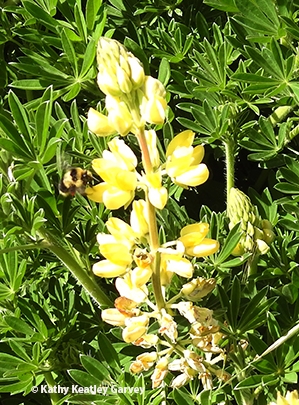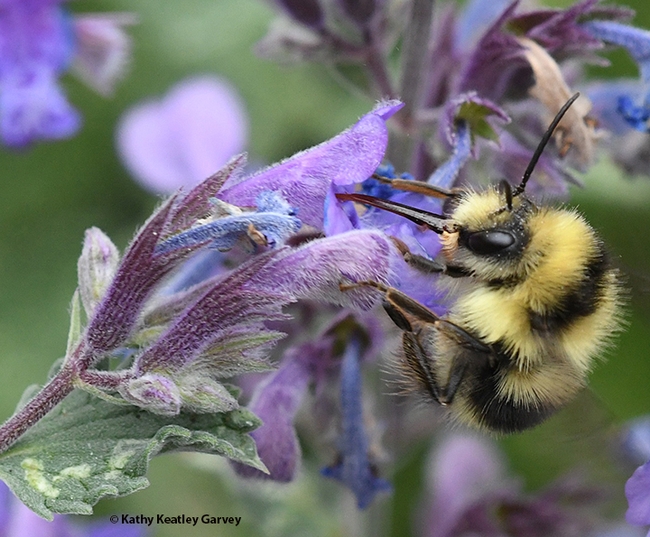- Author: Kathy Keatley Garvey

Windy? 27 mph!
We didn't think we'd see a single bumble bee foraging on the blooming ice plants, poppies, wild radishes, or lupines, but there it was, a black-tailed bumble bee, Bombus melanopygus, nectaring on a yellow lupine near the entrance to Doran Regional Park.
This bumble bee species is one of the earliest to emerge in the spring. We've seen it as early as Jan. 1 in Benicia. And the Bohart Museum of Entomology, UC Davis, coordinates a contest to see who can find and photograph the first bumble bee of the year in the two-county area of Yolo and Solano. This year Ria de Grassi of Davis spotted a B. melanopygus, foraging on her ceanothus plant in her backyard on Jan. 8. (See Bug Squad blog.)
But back to the Bombus at Bodega. How can a tiny bumble bee, ranging from 0.6 to 1 inch in length, withstand that 27 mph wind, which seemed near gale force? Bumble bees pay no attention to gale force, which the National Weather Service defines as between 34 and 47 knots (39 to 54 mph).
Bumble bee authority John Ascher messaged me: "Their flight and resistance to cold is amazing!" Truly!
"Powerful flight muscles are packed into their stout little bodies, which are covered in thick fur," according to an Aug. 2, 2021 post in Imprint Ecology, Chichester, West Sussex, England. "These can propel them through high winds, in comparison to honeybees and butterflies who find it difficult to get airborne in wind above 20 mph. In addition, bumblebees can dislocate their flight muscles and shiver them to keep warm which is very useful on wet, windy days. Even in winter, you can see big queen bumblebees happily foraging on gorse, heather and crocus, when no other insects are out and temperatures have barely reached double figures."
"Bumblebees evolved in the Himalayas, around 25 to 40 million years ago. They are designed to withstand bleak, windy, mountainous climates and don't actually fare very well in hot places."
The black-tailed bumble bee predominantly has pale yellow hair "with bands of black hair between the wing bases and across the middle of the abdomen," according to the quartet of UC-based scientists, Gordon Frankie, (the late) Robbin Thorp, Rollin Coville and Barbara Ertter, in their book, California Bees and Blooms: A Guide for Gardeners and Naturalists.
They also forage quickly, especially in a strong wind...or an uninvited gust.



